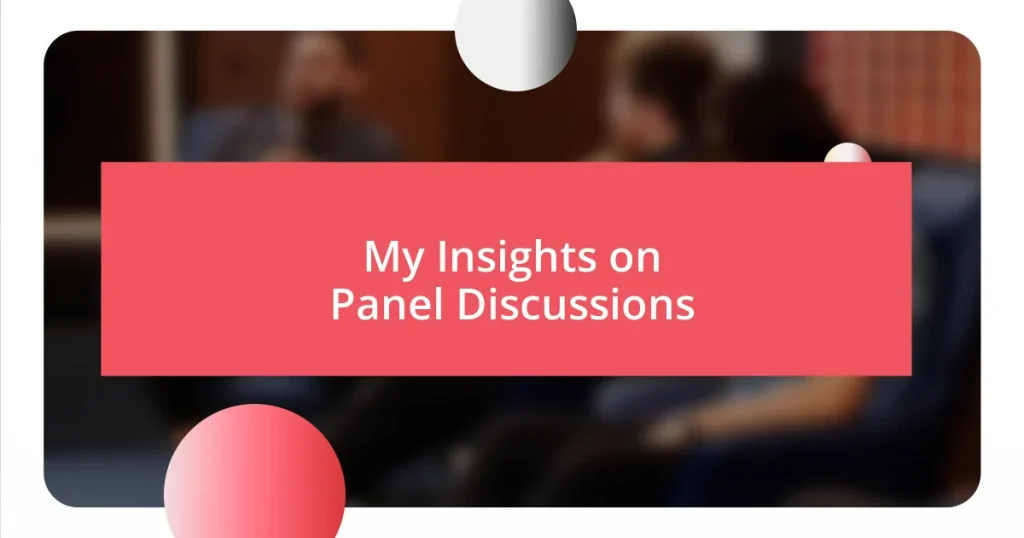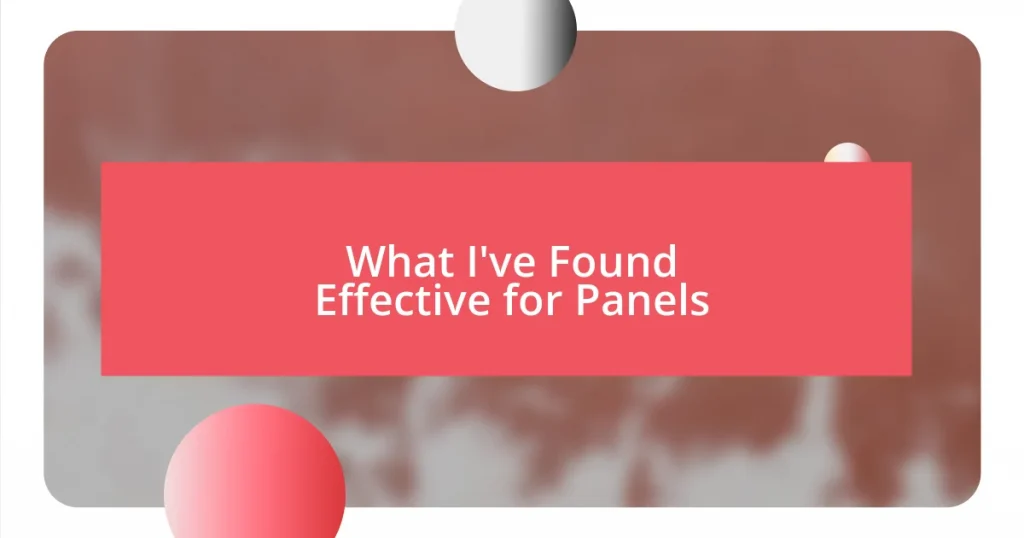Key takeaways:
- Panel discussions enable diverse perspectives, enhancing audience engagement and prompting personal connections through shared experiences.
- Selecting a diverse range of knowledgeable panelists is crucial for enriching dialogue and creating a dynamic, authentic conversation.
- Audience interaction and technology can significantly transform panel discussions, fostering a collaborative environment that inspires lasting change.

Understanding Panel Discussions
Panel discussions are fascinating platforms where diverse perspectives come together to address a specific theme or issue. I remember sitting in on a panel about sustainable living, and the energy in the room was palpable. It made me realize how these discussions create a unique space for both experts and audience members to connect.
When you think about panel discussions, do you ever wonder how they can influence public opinion? Each panelist typically brings their own experiences and insights, which can deeply resonate with the audience. For instance, one of the panelists shared a personal story about their journey toward eco-friendly practices, which sparked an emotional connection that inspired many attendees to reconsider their own habits.
What truly excites me about panel discussions is the dynamic nature of conversation. Unlike traditional lectures, these engagements allow for a back-and-forth dialogue, often leading to richer insights. I can recall a time when a simple question from the audience shifted the entire focus of the discussion, demonstrating how spontaneous interactions can lead to unexpected revelations.

Importance of Audience Engagement
Engaging the audience is crucial because it transforms a passive experience into an interactive one. I vividly remember attending a panel where the moderator encouraged questions not just at the end but throughout the discussion. This approach made me feel like an integral part of the conversation, igniting my curiosity and prompting me to share my own thoughts as well.
Having the audience actively involved not only enhances their experience but can also influence the direction of the dialogue. For instance, during a healthcare panel I was part of, one audience member posed a challenging question about accessibility. This exchange added valuable dimensions to the discussion and highlighted needs that the panelists might not have considered, proving how much richer the insights can be with audience participation.
In my experience, when panel discussions foster audience engagement, they create a community atmosphere. It’s like sharing a meal with friends; the conversation flows, insights are shared, and everyone leaves feeling enriched. I once saw how a simple thumbs-up or nod from an audience member could encourage a panelist to dive deeper into a topic, showcasing the profound impact engagement has on the depth of conversation.
| Engagement Method | Effect |
|---|---|
| Direct Questions from Audience | Encourages spontaneity and diverse perspectives |
| Real-time Polling | Involves audience opinions instantaneously |

Selecting the Right Panelists
Selecting the right panelists is a vital step in crafting an engaging and insightful discussion. From my own experiences, I’ve often noticed that the success of a panel can hinge on the diversity of backgrounds and viewpoints represented. For instance, in one session I attended about technology in education, the panelists included a teacher, a tech entrepreneur, and a student. Each brought a unique lens to the conversation that not only enriched the dialogue but also resonated deeply with the audience.
When it comes to choosing panelists, consider the following:
- Expertise and Knowledge: Ensure panelists have a solid grasp of the topic at hand. Their authority gives weight to the discussion.
- Diversity of Perspectives: Aim for a mix of experiences, backgrounds, and viewpoints. This diversity leads to a richer dialogue and more nuanced insights.
- Communication Skills: Select individuals who can articulate their thoughts clearly and engage with both the audience and fellow panelists. Effective communication can boost the overall energy of the session.
- Passion for the Topic: Panelists who are genuinely invested in the subject matter tend to ignite enthusiasm, making the discussion more lively and relatable.
I recall a panel on mental health where one of the speakers had a personal journey of overcoming adversity. Their candidness and passion were palpable, creating a safe space for the audience to share their own experiences. This authenticity not only enriched the conversation but built a supportive atmosphere that everyone appreciated. It reminded me of the power that the right panelists can have in transforming a discussion into a meaningful exchange.

Preparing Effective Discussion Topics
When preparing effective discussion topics, I find it essential to align them with the interests and knowledge base of both the panelists and the audience. One time, I was involved in a discussion about sustainability, and we centered our topics on practical applications rather than just theory. The shift in focus sparked lively dialogue, as audience members could relate their experiences, turning the session into a collaborative brainstorming event rather than a one-sided lecture.
It’s also crucial to include open-ended questions in the discussion topics. For instance, I remember approaching a topic on remote work with a question like, “How has remote work reshaped your perception of work-life balance?” This simple shift invited personal stories and insights, making everyone feel included. It’s fascinating how one thoughtful inquiry can significantly deepen the experience and foster connection among participants.
Additionally, consider the current trends or hot-button issues relevant to your audience. During a recent panel on mental health, we included questions around social media’s impact on well-being. Given the intense conversations happening globally, this topic resonated deeply and prompted honest sharing among both the panelists and the audience. Reflecting on these moments, I realize how tailored topics can bridge gaps and invite enriching dialogue, making every discussion not just informative but transformative.

Facilitating a Dynamic Conversation
Facilitating a dynamic conversation is all about striking the right balance between structure and spontaneity. I remember a panel where the moderator had a knack for weaving in audience questions at just the right moments, making participants feel valued and engaged. It reminded me how crucial it is to remain flexible; sometimes, the best insights emerge from unexpected exchanges.
Creating an inviting atmosphere also plays a significant role in energizing the discussion. In one of my experiences, we set up the seating in a circle instead of in rows. This small change encouraged eye contact and open body language among panelists and the audience, creating a sense of community. Can you imagine how such simple adjustments can change the tone of a conversation? I’ve seen firsthand how this fosters not just dialogue, but a deeper connection.
Encouraging panelists to share personal narratives can also elevate the conversation. I’ve observed instances when a panelist spoke about their failure before sharing their success. The authenticity pulled the audience in and made them feel like they were part of a story, rather than passive observers. Those moments felt like shared experiences, blending professional insights with emotional resonance, which is the sweet spot for any dynamic discussion.

Encouraging Audience Interaction
Encouraging audience interaction truly transforms the atmosphere of a panel discussion. I recall sitting in a session where the moderator openly invited those attending to share their thoughts at various points. It was exhilarating to see how quickly participants lit up, raising hands to contribute personal anecdotes. Have you ever noticed how a simple invitation can shift the energy of a room? I certainly have—it creates an environment where everyone feels they have a stake in the conversation.
To further foster engagement, I advocate for using technology as a bridge. In one discussion, we implemented live polling to gauge audience opinions on contentious topics. The immediate feedback was astonishing; not only did it spark real-time debate, but it also provided invaluable insights that shaped the direction of our conversation. It made me reflect on how embracing digital tools could turn passive listeners into active participants, crafting a richer collective narrative.
I also believe that humor can be a powerful tool for breaking the ice and encouraging interaction. I’ve experienced moments where a light-hearted comment about a shared challenge—like navigating everyday distractions—made the audience chuckle and feel at ease. This openness transformed their apprehension into a willingness to speak up and share their own stories. Doesn’t it feel great when laughter creates connections? From my perspective, such playful exchanges pave the way for authentic dialogue, making each voice heard and valued.

Evaluating the Panel’s Impact
Evaluating a panel’s impact goes beyond surface-level feedback; it’s about understanding how it resonates with the audience long after the discussion has ended. I remember moderating a panel on sustainable living, and the audience’s energy shifted dramatically when a panelist shared their personal journey of transitioning to a zero-waste lifestyle. I could see the spark in people’s eyes, which made me reflect on how powerful relatable stories can be in inspiring change.
Another aspect that I find essential in evaluating impact is post-panel reflections. After one event, we conducted a follow-up survey and were amazed to discover that many attendees felt motivated enough to implement new practices in their lives. It struck me how conversations can ignite action when they touch on personal values. Isn’t it fascinating to think that a simple discussion can serve as a catalyst for significant lifestyle changes?
I’ve also come to appreciate the nuances of audience feedback in crafting future discussions. At one panel, we received a heartfelt comment from an attendee who shared how a particular debate had shifted their perspective on mental health in the workplace. Hearing such testimonials gave me insights into the long-term effects of our conversations. It’s moments like these that remind me: what we discuss matters, but so does how it resonates and inspires action in others. How can we ensure our discussions continue to leave a lasting impact?














